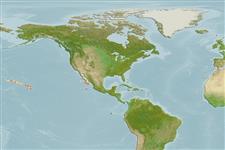Classification / Names
Noms communs | Synonymes | Catalog of Fishes(Genre, Espèce) | ITIS | CoL | WoRMS | Cloffa
>
Gadiformes (Cods) >
Macrouridae (Grenadiers or rattails)
Etymology: Hymenocephalus: Named for its transparent membrane-like head covering (‘‘hymen head’’) and fragile nature of head bones (Ref. 100825).
More on authors: Gilbert & Cramer.
Environment: milieu / climate zone / depth range / distribution range
Écologie
marin benthopélagique; profondeur 450 - 799 m (Ref. 58302). Deep-water
Eastern Central Pacific: Hawaiian Islands.
Taille / Poids / Âge
Maturity: Lm ? range ? - ? cm
Description synthétique
Morphologie | Morphométrie
This species is distinguished by the following characters: pelvic fin rays 11-12 (usually 12); pectoral fin rays 13-15 (seldom 16); short projecting snout, 15-18% HL; short barbel, 3-4% HL, large orbit diameter, 35-40% HL; infraorbital width 8-10% HL; moderately long preopercular supporter, with obtuse angle at rear margin, 5-7% HL; 21-24 gill rakers; ventral striae reaching to ½ distance from pelvic fin bases to periproct; otolith has high predorsal lobe, with colliculi separated, closely placed across collum, with occasional tendency to partly join, terminating at some distance from anterior and posterior rims of otolith; otolith length to height (OL:OH), 0.95-1.1; total colliculum length to pseudocolliculum length (TCL:PCL), 1.6-1.7 (Ref. 98298).
Benthopelagic (Ref. 58302).
Life cycle and mating behavior
Maturité | Reproduction | Frai | Œufs | Fécondité | Larves
Sazonov, Y.I. and T. Iwamoto, 1992. Grenadiers (Pisces, Gadiformes) of the Nazca and Sala y Gomez ridges, southeastern Pacific. Proc. Calif. Acad. Sci. 48(2):27-95. (Ref. 9949)
Statut dans la liste rouge de l'IUCN (Ref. 130435)
Menace pour l'homme
Harmless
Utilisations par l'homme
Plus d'informations
Noms communsSynonymesMétabolismePrédateursÉcotoxicologieReproductionMaturitéFraiRassemblement de ponteFéconditéŒufsDéveloppement de l'œuf
Taille/ÂgeCroissanceLongueur-poidsLongueur-longueurFréquences de longueursMorphométrieMorphologieLarvesDynamique des populations larvairesRecrutementAbondanceBRUVS
RéférencesAquacultureProfil d'aquacultureSouchesGénétiqueElectrophoresesHéritabilitéPathologiesTraitementNutrientsMass conversion
CollaborateursImagesStamps, Coins Misc.SonsCiguateraVitesseType de nageSurface branchialeOtolithesCerveauxVision
Outils
Articles particuliers
Télécharger en XML
Sources Internet
Estimates based on models
Preferred temperature (Ref.
123201): 4.7 - 6.8, mean 5.6 °C (based on 4 cells).
Phylogenetic diversity index (Ref.
82804): PD
50 = 0.5000 [Uniqueness, from 0.5 = low to 2.0 = high].
Bayesian length-weight: a=0.00219 (0.00111 - 0.00431), b=3.20 (3.03 - 3.37), in cm total length, based on LWR estimates for this (Sub)family-body shape (Ref.
93245).
Niveau trophique (Ref.
69278): 3.3 ±0.4 se; based on size and trophs of closest relatives
Résilience (Ref.
120179): Milieu, temps minimum de doublement de population : 1,4 à 4,4 années (Preliminary K or Fecundity.).
Fishing Vulnerability (Ref.
59153): Low vulnerability (10 of 100).
